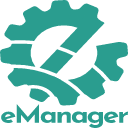Introduction
Welcome to e-Manager Accounting App, a comprehensive financial management solution designed to streamline and simplify your business operations. Whether you are managing income, expenses, taxes, inventory, or customer relationships, e-Manager offers a centralized platform to handle all essential accounting tasks with ease and efficiency.
This documentation provides detailed information about the features and functionalities available in the system, organized into clearly defined modules for easy navigation and understanding. Each module is built to support real-time data management, improve financial accuracy, and enhance decision-making through intuitive dashboards and reports.
Key Capabilities:
-
Company and system settings management
-
In-depth reporting and analytics
-
Full income and expense tracking
-
Customer and vendor relationship management
-
Tax, currency, and localization controls
-
Inventory and stock management
-
Secure data import/export features
e-Manager is suitable for small to medium-sized businesses looking to gain better visibility and control over their financial operations.

